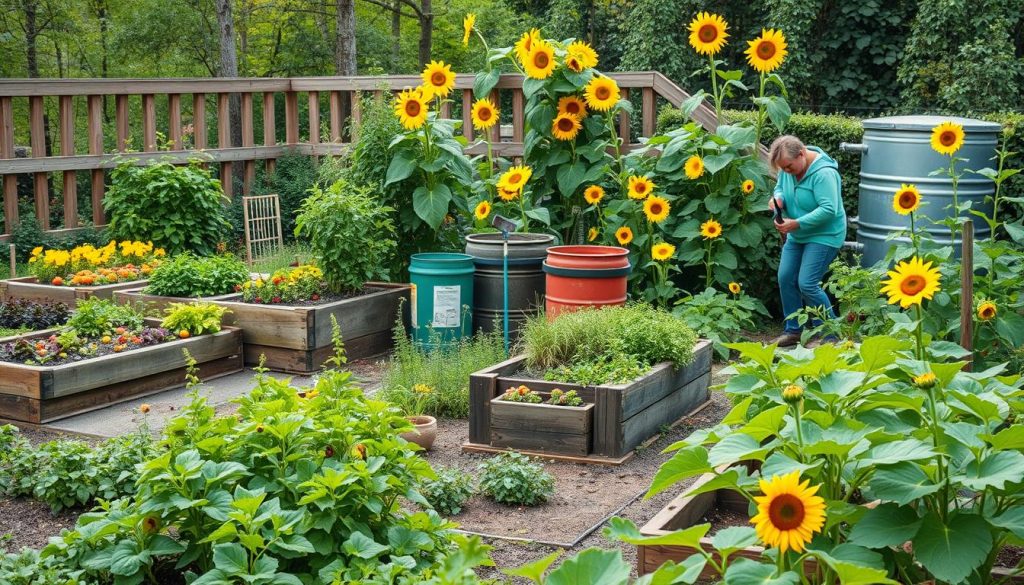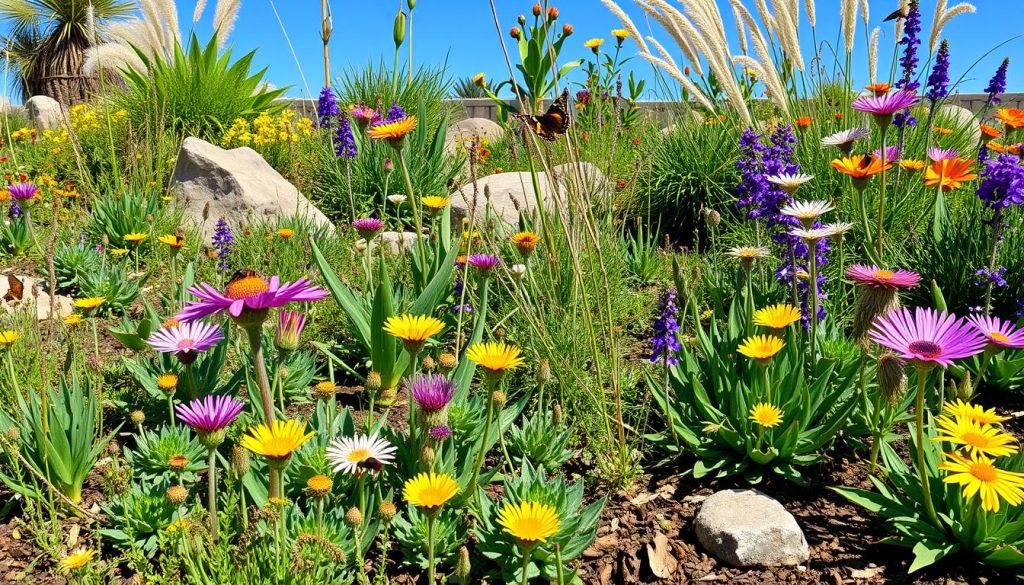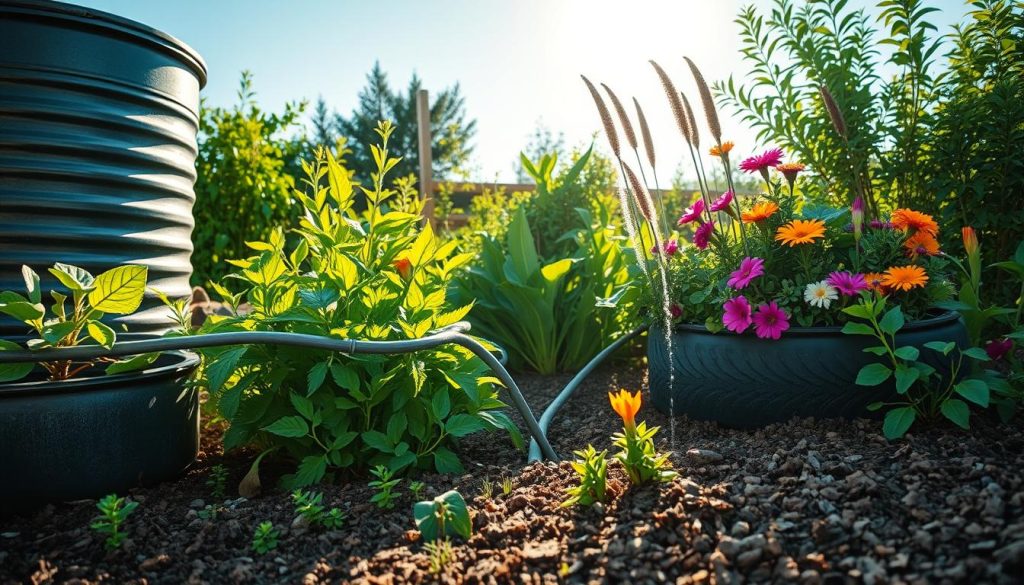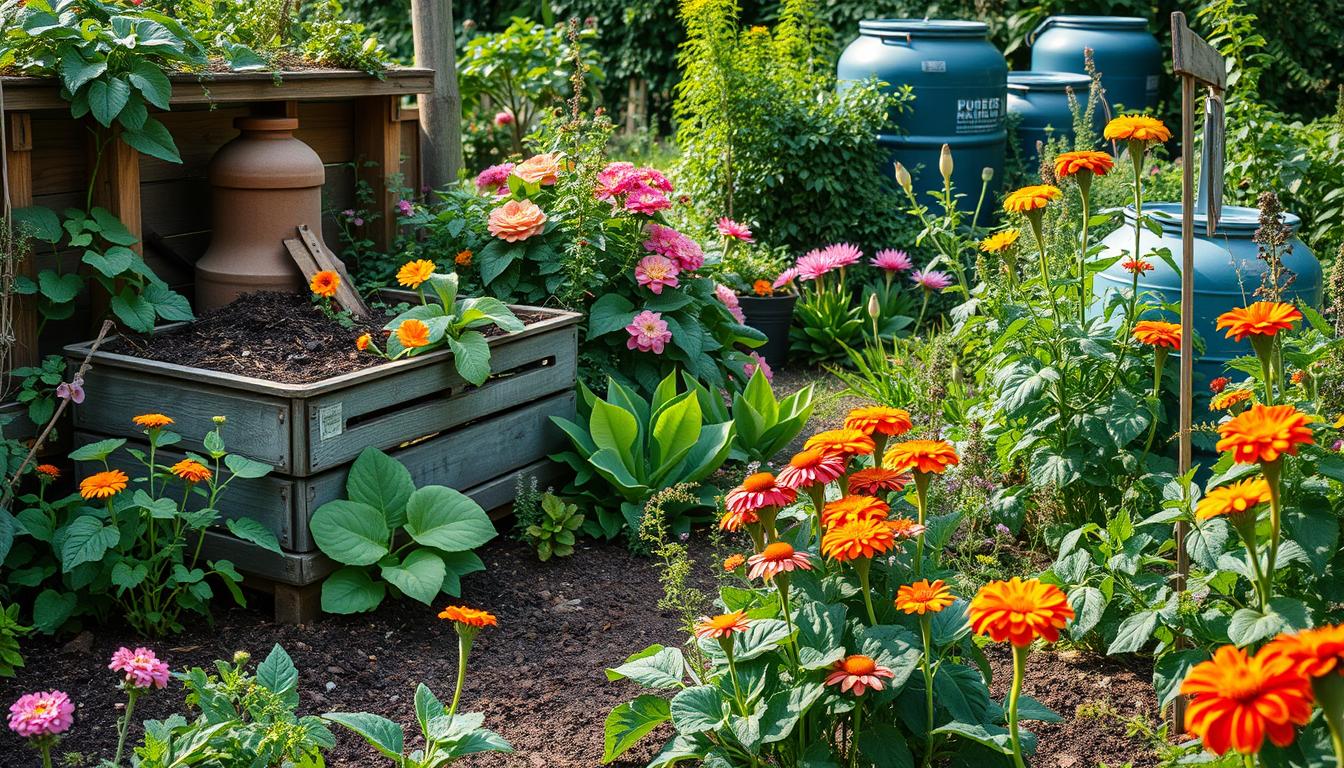I’m excited to share my experience with eco-friendly gardening. I’ll give you tips to make a beautiful, green garden. These practices will help your garden thrive and be good for the planet.
Exploring sustainable gardening, I learned how important it is. Choosing the right plants and natural pest control are key. I’ll share my favorite tips to help you start your eco-friendly garden.
Using eco-friendly gardening practices will make your garden stunning and green. It’s great for you and the planet. Let’s start this journey to a sustainable garden together.
Understanding Eco-Friendly Gardening Practices
Eco-friendly gardening means making our outdoor spaces better for the planet. We use organic and green methods to do this. These practices help our environment and make gardening healthier for us.
Some key benefits of sustainable gardening are:
- Conservation of water and reduction of waste
- Increased biodiversity and ecosystem health
- Reduced use of chemical pesticides and fertilizers
- Creation of a natural and balanced ecosystem
Organic gardening, like composting and natural pest control, makes our gardens thrive. Green gardening, like using rainwater and drought-resistant plants, also helps the environment. These changes make our gardens beautiful and good for the planet.

As gardeners, we must keep learning about sustainable gardening. By using these methods, we help the environment and enjoy the benefits of eco-friendly gardening.
Choosing Native Plants for My Garden
I’ve learned that using native plants in my garden is key. These plants fit well with our local climate and soil. This means I don’t need to use as many fertilizers and pesticides.
This choice is good for the environment and makes my garden easier to care for. Native plants help me garden in a way that’s better for nature.
Native plants help my garden use less water and make less waste. They offer many benefits, like:
- Improved soil health
- Increased biodiversity
- Enhanced ecosystem services
- Reduced maintenance requirements
When picking native plants, I think about sunlight, soil, and moisture. I look for plants that do well in my area’s climate. Choosing native plants makes my garden beautiful and helps the local ecosystem.

Composting: Turning Waste into Gold
Exploring earth-friendly gardening tips, I’ve learned composting is key. It reduces waste and makes soil rich. By using sustainable gardening tips, I help the environment and grow a healthy garden.
Getting Started with Composting
To start composting, I collect organic stuff like food scraps and leaves. I put them in a compost bin where they break down. It’s important to mix “green” and “brown” materials for good composting.
What to Compost and What to Avoid
Knowing what to compost and what not is crucial. Here’s what to include and avoid:
- Fruit and vegetable scraps
- Tea bags and coffee grounds
- Grass clippings and leaves
- Manure from herbivores
I don’t compost meat, dairy, or oily foods. They attract pests and smell bad. By composting right, I make a nutrient-rich soil for my garden and the planet.

Composting and sustainable gardening reduce waste and make my garden healthy. Always use earth-friendly tips to keep our planet green and our gardens beautiful.
| Composting Materials | Benefits |
|---|---|
| Fruit and vegetable scraps | Rich in nutrients, adds organic matter |
| Leaves and grass clippings | Provides carbon, helps with decomposition |
| Manure from herbivores | Rich in nutrients, improves soil structure |
Water Conservation Techniques I Use
As I work on making my garden more eco-friendly, I’ve learned how crucial water conservation is. Using green gardening methods has cut down my water waste and made my garden more sustainable. One key technique I use is rainwater harvesting, which collects and stores rainwater for watering plants.
To harvest rainwater, I’ve set up a simple system with a large barrel and a downspout diverter. This lets me collect and store rainwater for my plants. I’ve also added drought-resistant plants to my garden. These plants need less water and can grow well even when it’s dry. Succulents and cacti are some of my favorites.
Rainwater Harvesting Ideas
- Use a large barrel or tank to collect and store rainwater
- Install a downspout diverter to direct rainwater into the barrel
- Use a first flush device to divert debris and contaminants from the roof
Drought-Resistant Plants to Consider
I’ve also used other water-saving methods in my garden, like mulching and drip irrigation. These help cut down on evaporation and runoff. This way, my plants get the water they need without wasting it. By using these eco-friendly practices, I’ve made my garden more sustainable and water-efficient.

| Plant | Water Requirements |
|---|---|
| Succulents | Low |
| Cacti | Low |
| Drought-resistant grasses | Medium |
Organic Pest Control Methods
As I grow my eco-friendly garden, I’ve learned the value of organic pest control. It keeps my garden healthy and balanced. Using organic methods means no harmful chemicals or pesticides.
Natural Pest Deterrents
I’ve found that natural pest deterrents work well. Neem oil and diatomaceous earth keep pests away without harming good bugs. These practices are key to my garden’s health.
Here are some natural pest deterrents I use:
- Neem oil to control insects and mites
- Diatomaceous earth to repel slugs and snails
- Garlic spray to deter aphids and whiteflies
Building a Healthy Ecosystem
Creating a healthy garden ecosystem is vital. Organic gardening and natural practices help. They make my garden diverse and strong, attracting good bugs and promoting plant health.
Soil Health and Sustainability
As I work on making my garden more eco-friendly, I’ve learned how key soil health is. Healthy soil is the base of a great garden. It needs care to stay that way. By using sustainable gardening tips, I keep my soil rich and help my plants grow well.
Testing Soil Quality
To check my soil’s health, I test it often. I can send a sample to a lab or use a DIY kit. The test tells me about the soil’s pH, nutrients, and structure. Then, I can tweak my gardening to make the soil better.
Adding Organic Matter
Adding organic stuff is vital for soil health. I mix in compost, manure, or green manure. This boosts the soil in many ways:
- It makes the soil better for plants
- It helps with water in the soil
- It brings more life and services to the garden
By following these tips, my garden becomes a green space for plants and animals.
Seasonal Gardening Tips for Eco-Friendliness
To keep my garden eco-friendly, I use seasonal gardening. This method lets me grow many different crops. It cuts down on the need for harmful chemicals.
By using earth-friendly tips, my garden becomes strong and adapts well to different weather.
What to Plant in Each Season
Here’s a guide for planting in each season:
- Spring: Plant cool-season crops like broccoli, kale, and spinach.
- Summer: Focus on warm-season crops like tomatoes, peppers, and eggplants.
- Autumn: Plant cool-season crops like carrots, beets, and lettuce.
- Winter: Grow cold-hardy crops like Brussels sprouts, cabbage, and kale.
Timing My Planting for Sustainability
Planting at the right time is key for sustainable gardening. It helps avoid waste and cuts down on harmful chemicals. Here’s a table to guide me:
| Season | Crop | Planting Time |
|---|---|---|
| Spring | Broccoli | 4-6 weeks before last frost |
| Summer | Tomatoes | 1-2 weeks after last frost |
| Autumn | Carrots | 8-10 weeks before first frost |
| Winter | Brussels Sprouts | 12-14 weeks before first frost |
By using these seasonal tips, I can make a garden that’s good for the planet.
Tools and Materials That Save Resources
As I work on my green gardening, I’ve learned the value of eco-friendly tools and materials. Using natural gardening practices helps cut down on waste and lessens my impact on the environment. In my garden, I’ve started using tools made from sustainable materials like bamboo and recycled metals.
Some of the eco-friendly gardening tools I rely on include:
- Bamboo rakes and hoes
- Recycled metal watering cans
- Compost bins made from natural materials
Eco-Friendly Gardening Tools I Rely On
These tools not only reduce waste but also support natural gardening. By using them, I create a sustainable garden that’s good for the environment.
Sustainable Mulching Options
To cut down on waste and keep the soil moist, I use sustainable mulching. Wood chips and leaves are great options. They help control weeds and keep the soil temperature right, making it better for my plants.
The Importance of Pollinators in My Garden
As I work on my garden, I’ve learned how crucial pollinators are. They keep my garden healthy and sustainable. I attract them by planting a variety of flowers and herbs.
Attracting Bees and Butterflies
I choose plants like lavender and coneflower to draw in bees and butterflies. These plants are not just pretty; they also feed the pollinators. Other plants I use include:
- Sunflowers
- Zinnias
- Cosmos
- Marigolds
These flowers make my garden a haven for pollinators. They also add beauty and color to my outdoor space.
Creating Habitats for Pollinators
I also build bee hotels and butterfly gardens. These provide a safe place for pollinators to nest and lay eggs. It’s great for the local ecosystem.
By gardening organically and using sustainable tips, my garden is full of life. It attracts pollinators and supports a healthy ecosystem. This benefits my garden and the environment.
Enhancing Biodiversity in My Garden
To make my garden thrive, I focus on biodiversity. This helps the environment and makes my garden healthier. By using eco-friendly gardening, I attract beneficial insects and animals. This keeps my garden balanced.
Companion Planting Techniques I Use
I use companion planting to make my garden diverse and harmonious. Some of my techniques include:
- Planting marigolds with tomatoes to deter nematodes
- Planting basil with lettuce to improve flavor and repel pests
- Planting beans with corn and squash to create a symbiotic relationship
These methods help my plants grow well, fight pests, and increase biodiversity.
Benefits of a Diverse Plant Selection
A diverse plant selection is key for a healthy garden. It offers many benefits, such as:
- Improved soil health through increased microbial activity
- Increased resistance to pests and diseases
- Enhanced pollination and fruit production
By having different plants, my garden becomes more resilient against challenges.
Sharing My Eco-Friendly Gardening Experience
Looking back on my eco-friendly gardening journey, I feel proud and accomplished. I’ve turned my outdoor space into a lush, sustainable oasis. This change has not only helped the environment but has also made my life better in many ways.
By using sustainable gardening tips and earth-friendly gardening practices, I’ve made a space that feeds my soul and helps the local ecosystem.
Community Gardens and Sharing Resources
Connecting with my local community has been incredibly rewarding. I’ve joined community gardens where we share knowledge, resources, and our harvest. It’s amazing to see how people working together can make a big difference for the environment and build a strong community.
Encouraging Others to Go Green in Gardening
I want to inspire others to use sustainable gardening tips and enjoy earth-friendly gardening. I’ve shared my experiences with friends, neighbors, and gardening clubs. I hope to encourage them to see the benefits of eco-friendly gardening.
By showing them how it’s done and offering practical advice, I aim to help make our community and planet greener.

